Predator Scent-Induced Sensitization of Hypertension and Anxiety-like Behaviors
- PMID: 33201417
- PMCID: PMC8126575
- DOI: 10.1007/s10571-020-01005-y
Predator Scent-Induced Sensitization of Hypertension and Anxiety-like Behaviors
Abstract
Post-traumatic stress disorder (PTSD), an anxiety-related syndrome, is associated with increased risk for cardiovascular diseases. The present study investigated whether predator scent (PS) stress, a model of PTSD, induces sensitization of hypertension and anxiety-like behaviors and underlying mechanisms related to renin-angiotensin systems (RAS) and inflammation. Coyote urine, as a PS stressor, was used to model PTSD. After PS exposures, separate cohorts of rats were studied for hypertensive response sensitization (HTRS), anxiety-like behaviors, and changes in plasma levels and mRNA expression of several components of the RAS and proinflammatory cytokines (PICs) in the lamina terminalis (LT), paraventricular nucleus (PVN), and amygdala (AMY). Rats exposed to PS as compared to control animals exhibited (1) a significantly greater hypertensive response (i.e., HTRS) when challenged with a slow-pressor dose of angiotensin (ANG) II, (2) significant decrease in locomotor activity and increase in time spent in the closed arms of a plus maze as well as general immobility (i.e., behavioral signs of increased anxiety), (3) upregulated plasma levels of ANG II and interleukin-6, and (4) increased expression of message for components of the RAS and PICs in key brain nuclei. All the PS-induced adverse effects were blocked by pretreatment with either an angiotensin-converting enzyme antagonist or a tumor necrosis factor-α inhibitor. The results suggest that PS, used as an experimental model of PTSD, sensitizes ANG II-induced hypertension and produces behavioral signs of anxiety, probably through upregulation of RAS components and inflammatory markers in plasma and brain areas associated with anxiety and blood pressure control.
Keywords: Behavior; Blood pressure; Inflammation; Predator scent stress; Renin–angiotensin system.
© 2020. Springer Science+Business Media, LLC, part of Springer Nature.
Conflict of interest statement
The authors declared that they have no conflicts of interest.
Figures

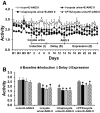
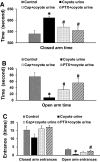
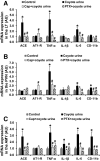
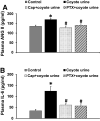
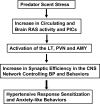
Similar articles
-
Stress-Induced Sensitization of Angiotensin II Hypertension Is Reversed by Blockade of Angiotensin-Converting Enzyme or Tumor Necrosis Factor-α.Am J Hypertens. 2019 Aug 14;32(9):909-917. doi: 10.1093/ajh/hpz075. Am J Hypertens. 2019. PMID: 31063551 Free PMC article.
-
Blockade of angiotensin-converting enzyme or tumor necrosis factor-α reverses maternal high-fat diet-induced sensitization of angiotensin II hypertension in male rat offspring.Am J Physiol Regul Integr Comp Physiol. 2020 Feb 1;318(2):R351-R359. doi: 10.1152/ajpregu.00200.2019. Epub 2019 Nov 20. Am J Physiol Regul Integr Comp Physiol. 2020. PMID: 31746626 Free PMC article.
-
Maternal high-fat diet acts on the brain to induce baroreflex dysfunction and sensitization of angiotensin II-induced hypertension in adult offspring.Am J Physiol Heart Circ Physiol. 2018 May 1;314(5):H1061-H1069. doi: 10.1152/ajpheart.00698.2017. Epub 2018 Jan 26. Am J Physiol Heart Circ Physiol. 2018. PMID: 29373045 Free PMC article.
-
Central Renin-Angiotensin System Activation and Inflammation Induced by High-Fat Diet Sensitize Angiotensin II-Elicited Hypertension.Hypertension. 2016 Jan;67(1):163-70. doi: 10.1161/HYPERTENSIONAHA.115.06263. Epub 2015 Nov 16. Hypertension. 2016. PMID: 26573717 Free PMC article.
-
Sex differences in maternal gestational hypertension-induced sensitization of angiotensin II hypertension in rat offspring: the protective effect of estrogen.Am J Physiol Regul Integr Comp Physiol. 2018 Feb 1;314(2):R274-R281. doi: 10.1152/ajpregu.00216.2017. Epub 2017 Nov 14. Am J Physiol Regul Integr Comp Physiol. 2018. PMID: 29046315 Free PMC article.
Cited by
-
Rat Models in Post-Traumatic Stress Disorder Research: Strengths, Limitations, and Implications for Translational Studies.Pathophysiology. 2024 Dec 6;31(4):709-760. doi: 10.3390/pathophysiology31040051. Pathophysiology. 2024. PMID: 39728686 Free PMC article. Review.
-
Involvement of the Renin-Angiotensin System in Stress: State of the Art and Research Perspectives.Curr Neuropharmacol. 2022;20(6):1212-1228. doi: 10.2174/1570159X19666210719142300. Curr Neuropharmacol. 2022. PMID: 34554902 Free PMC article. Review.
-
The microglial innate immune receptor TREM2 participates in fear memory formation through excessive prelimbic cortical synaptic pruning.Front Immunol. 2024 Oct 31;15:1412699. doi: 10.3389/fimmu.2024.1412699. eCollection 2024. Front Immunol. 2024. PMID: 39544929 Free PMC article.
-
PTSD Increases Risk for Hypertension Development Through PVN Activation and Vascular Dysfunction in Sprague Dawley Rats.Antioxidants (Basel). 2024 Nov 20;13(11):1423. doi: 10.3390/antiox13111423. Antioxidants (Basel). 2024. PMID: 39594564 Free PMC article.
-
Voluntary Exercise Prevents Hypertensive Response Sensitization Induced by Angiotensin II.Front Neurosci. 2022 Feb 17;16:848079. doi: 10.3389/fnins.2022.848079. eCollection 2022. Front Neurosci. 2022. PMID: 35250473 Free PMC article.
References
-
- Albrechet-Souza L, Gilpin NW (2019) The predator odor avoidance model of post-traumatic stress disorder in rats. Behav Pharmacol 30 (2 and 3-Spec Issue):105-114. https://doi.org/10.1097/FBP.0000000000000460 - PMC - PubMed
-
- Bali A, Jaggi AS (2013) Angiotensin as stress mediator: role of its receptor and interrelationships among other stress mediators and receptors. Pharmacol Res 76:49–57. 10.1016/j.phrs.2013.07.004 - PubMed
-
- Banfi C, Sironi L, De Simoni G, Gelosa P, Barcella S, Perego C, Gianazza E, Guerrini U, Tremoli E, Mussoni L (2004) Pentoxifylline prevents spontaneous brain ischemia in stroke-prone rats. J Pharmacol Exp Ther 310(3):890–895. 10.1124/jpet.104.067090 - PubMed
-
- Banks WA, Kastin AJ, Broadwell RD (1995) Passage of cytokines across the blood-brain barrier. Neuroimmunomodulation 2(4):241–248. 10.1159/000097202 - PubMed
-
- Burg MM, Soufer R (2016) Post-traumatic stress disorder and cardiovascular disease. Curr Cardiol Rep 18(10):94. 10.1007/s11886-016-0770-5 - PubMed
MeSH terms
Substances
Grants and funding
LinkOut - more resources
Full Text Sources
Medical
Miscellaneous

